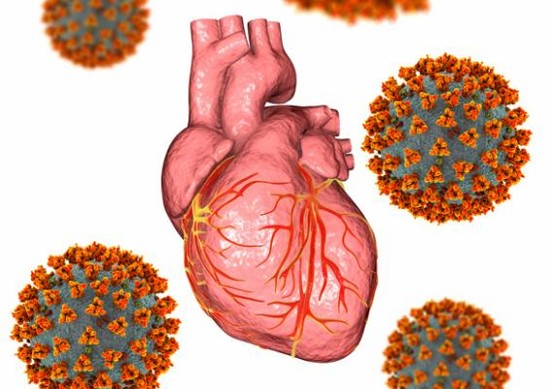
When the coronavirus known as COVID-19 or SARS-Cov-2 first emerged from Wuhan, China in 2019, the world changed dramatically. Not since the Black Death and Spanish Flu has the world seen such a disruptive pathogen inflict damage on humanity.
COVID-19 began its assault on us as a respiratory infection causing severe damage to lung tissue. The medical establishment applied the same technology and treatments as it had done in the past for severe pneumonia and other deadly lung infections. Detection of the virus was done by taking nose swabs.
When I got COVID-19 in April 2020, the tests didn’t detect the presence of the virus. I didn’t present initially with lung issues. It was several weeks before I began coughing, a common sign of the infection. Instead, my voice changed, not for tracheal or bronchial reasons, but because my heart had enlarged and was pressing on my larynx.
An emergency doctor who saw me was the first to describe what I was experiencing. COVID-19 had infected my heart muscle and caused the left upper chamber to swell. She said that they were seeing an increase in symptoms similar to mine in the emergency department which they were presuming were related to COVID-19 exposure.
What I thought was indigestion when I felt changes in my chest turned out to be arrhythmias. The electrical conduction pathways of my heart were being altered by the virus infecting the contractile muscle cells responsible for pumping blood through the circulatory system. An electrocardiogram (ECG) showed I was in atrial fibrillation with my heartbeat jumping all over the place. Wearing a portable ECG, a Holter Monitor, for two weeks showed I was experiencing episodes of tachycardia (racing heart), bradycardia (slower than normal heart) and occasional moments when the muscle stopped beating lasting up to five seconds. The latter happened when I was sleeping which was a frightening thing to learn. COVID-19 could have killed me in my sleep. Three years later, having had two procedures and taking blood thinners, and anti-arrhythmic twice daily, my heart muscle is back to its prior calm self.
A study published earlier this year in Nature Cardiovascular Research that from March 2020 to March 2022, the United States saw 90,160 excess cardiovascular deaths higher than expected. The spikes in heart-related mortality appeared from March to June 2020 during the first wave of COVID-19, and from June to November 2021, a second noted COVID-19 death peak. The little over 90,000 represented a small percentage when compared to the global death count which surpassed 18.2 million during the first two years of the pandemic.
The majority of these excess deaths happened in people 65 years old or older. This is consistent with population health studies that show those of that age or older or more likely to experience cardiovascular events. A significant number of deaths associated with the heart found the biggest spike, however, in young adults between the ages of 25 and 44. These included higher incidents of heart attacks, strokes and arrhythmias associated with COVID-19 with occurrences happening up to a year after the initial infection.
A 2022 Lancet study of 42 million U.S. medical records covering from January 2019 to March 2022 ended up recruiting over 4 million participants who had been tested for COVID-19. The study published in eClinicalMedicine revealed a much higher risk of heart-related diseases occurring in the year after having tested positive for COVID-19. Higher incidents of stroke, heart attacks, arrhythmias, myocarditis, ischemic cardiomyopathy, heart failure, hypertension and pulmonary embolisms appeared in these medical records.
Dr. Helene Glassberg, a cardiologist at the University of Pennsylvania Perelman School of Medicine, is quoted in a New York Times, September 7, 2023, article, stating “Early on, we saw the impact on the cardiovascular system during Covid illness…But now we’re seeing the long-term consequences in people who’ve had prior Covid.” Dr. Glassberg was not a participant in the Lancet study but concurs with what the data shows. Although there have been rare incidents of myocarditis occurring from vaccinated patients, something that vaccine skeptics like to point out, the risk of getting myocarditis from the virus is 28 times greater.
A Children’s Hospital of Philadelphia (CHOP) led research study published in Science Translational Medicine in August 2023 points to COVID-19-induced mitochondrial genetic changes as the possible agent leading to heart and other organ damage from the virus. The mitochondrion is an organelle found in every human cell. It has separate DNA and genes from the cell’s nuclear DNA.
Evidence shows the proteins found in COVID-19 have a fondness for mitochondrion. They bind with the organelle’s proteins to suppress mitochondrial gene expression. So, although the initial access for COVID-19 may be through our lungs, the damage to its mitochondria is temporary. Lung cells recover. That is not the case, however, in other organs, particularly in the heart, where damage is long-term.
States Douglas C. Wallace, Director of the Center for Mitochondrial and Epigenomic Medicine (CMEM) at CHOP, “We need to stop looking at COVID-19 as strictly an upper respiratory disease and start viewing it as a systemic disorder that impacts multiple organs. The continued dysfunction we observed in organs other than the lungs suggests that mitochondrial dysfunction could be causing long-term damage to the internal organs of these patients.”
Previous studies may have identified a mitochondrial function regulator that could lead to a new therapy for those suffering from Long COVID. Called microRNA 2392 (miR-2392), it could impede viral replication to stop long-term complications from COVID-19.








